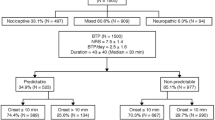Abstract
Introduction
Breakthrough pain (BTP) is traditionally defined as a transitory pain flare in opioid-treated patients with chronic background pain. This definition has, however, been challenged in recent years. This study aimed to analyze BTP prevalence in different pain conditions.
Methods
This was a prospective, noninterventional, observational study conducted from June to September 2011 in two Italian pain treatment reference centres. Consecutive patients aged >18 years with oncological or non-oncological pain were eligible for this study; background pain was acute/ subacute (<3 months) or chronic (>3 months). The characteristics of pain were evaluated by means of a structured interview by physicians, and patients were asked to complete a dedicated clinical study form.
The following outcomes were assessed: chronic pain duration (in patients with chronic pain), BTP prevalence, and number and severity of daily BTP episodes. All outcomes were assessed in four populations of patients with: (a) chronic oncological pain; (b) chronic non-oncological pain; (c) non-chronic oncological pain; (d) nonchronic non-oncological pain. The correlation between BTP and gender was also investigated.
Results
Of 1,270 patients with chronic pain, 1,086 had non-oncological pain (85.5%). Most patients (68.6%) with non-oncological pain were female (P = 0.001). Pain duration was significantly longer in non-oncological pain versus oncological pain groups (P = 0.002). BTP prevalence was lower in non-oncological patients (P < 0.001). No differences were reported in terms of number and severity of daily BTP episodes. BTP was more frequent in females with non-oncological pain (P = 0.04). Females had a significantly higher pain severity (P = 0.02) than males.
Conclusion
BTP is frequently reported in patients who do not have BTP according to the traditional definition. BTP frequency and severity is similar in oncological and non-oncological pain.
Similar content being viewed by others
References
Portenoy RK, Hagen NA. Breakthrough pain: definition and characteristics. Pain. 1990;41:273–281.
Portenoy RK, Bruns D, Shoemaker B, Shoemaker SA. Breakthrough pain in community-dwelling patients with cancer pain and noncancer pain, part 1: prevalence and characteristics. J Opioid Manag. 2010;6:97–108.
Greco MT, Corli O, Montanari M, et al., Writing Protocol Committee; Cancer Pain Outcome Research Study Group (CPOR SG) Investigators. Epidemiology and pattern of care of breakthrough cancer pain in a longitudinal sample of cancer patients: results from the Cancer Pain Outcome Research Study Group. Clin J Pain. 2011;27:9–18.
Caraceni A, Martini C, Zecca E, et al., Working Group of an IASP Task Force on Cancer Pain. Breakthrough pain characteristics and syndromes in patients with cancer pain. An international survey. Palliat Med. 2004;18:177–183.
Portenoy RK, Bruns D, Shoemaker B, Shoemaker SA. Breakthrough pain in community-dwelling patients with cancer pain and noncancer pain, part 2: impact on function, mood, and quality of life. J Opioid Manag. 2010;6:109–116.
Webster LR: Breakthrough pain in the management of chronic persistent pain syndromes. Am J Manag Care. 2008;14(5 Suppl. 1):S116–S122.
Breivik H, Cherny N, Collett B, et al. Cancer-related pain: a pan-European survey of prevalence, treatment, and patient attitudes. Ann Oncol. 2009;20:1420–1433.
Zeppetella G. Impact and management of breakthrough pain in cancer. Curr Opin Support Palliat Care. 2009;3:1–6.
Portenoy RK, Bennett DS, Rauck R, et al. Prevalence and characteristics of breakthrough pain in opioidtreated patients with chronic noncancer pain. J Pain. 2006;7:583–591.
Svendsen KB, Andersen S, Arnason S, et al. Breakthrough pain in malignant and non-malignant diseases: a review of prevalence, characteristics and mechanisms. Eur J Pain. 2005;9:195–206.
Smith H. A comprehensive review of rapidonset opioids for breakthrough pain. CNS Drugs. 2012;26:509–535.
Gatti A, Mediati RD, Reale C, et al. Breakthrough pain in patients referred to pain clinics: the Italian pain network retrospective study. Adv Ther. 2012;29:464–472.
Haugen DF, Hjermstad MJ, Hagen N, Caraceni A, Kaasa S;European Palliative Care Research Collaborative (EPCRC). Assessment and classification of cancer breakthrough pain: a systematic literature review. Pain. 2010;149:476–482.
Caraceni A, Bertetto O, Labianca R, et al; Breakthrough/Episodic Pain Italian Study Group. Episodic (Breakthrough) Pain Prevalence in a Population of Cancer Pain Patients. Comparison of Clinical Diagnoses With the QUDEI-Italian Questionnaire for Intense Episodic Pain. J Pain Symptom Managem. 2012;43:833–841.
Zeppetella G, Ribeiro MD. Opioids for the management of breakthrough (episodic) pain in cancer patients. Cochrane Database Syst Rev. 2006;1:CD004311.
Coluzzi PH. Cancer pain management: newer perspectives on opioids and episodic pain. Am J Hosp Palliat Care. 1998;15:13–22.
Davies A, Zeppetella G, Andersen S, et al. Multicentre European study of breakthrough cancer pain: pain characteristics and patient perceptions of current and potential management strategies. Eur J Pain. 2011;15:756–763.
McQuay HJ, Jadad AR. Incident pain. Cancer Surv. 1994;21:17–24.
Silverman SL. From randomized controlled trials to observational studies. Am J Med. 2009;122:114–122.
Author information
Authors and Affiliations
Corresponding author
Additional information
To view enhanced content go to www.advancesintherapy.com
Rights and permissions
About this article
Cite this article
Gatti, A., Gentili, M., Iorno, V. et al. Beyond the Traditional Definition of Breakthrough Pain: An Observational Study. Adv Therapy 30, 298–305 (2013). https://doi.org/10.1007/s12325-013-0013-8
Received:
Published:
Issue Date:
DOI: https://doi.org/10.1007/s12325-013-0013-8




